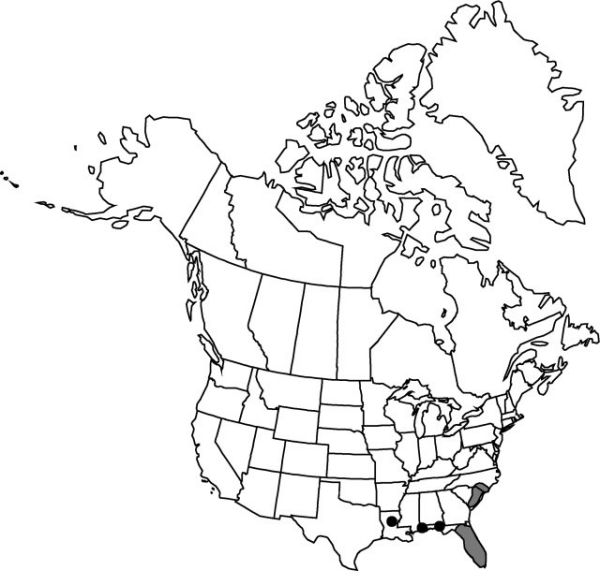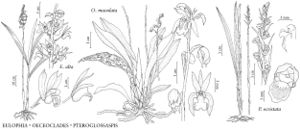Difference between revisions of "Pteroglossaspis ecristata"
Orchid Rev. 12: 136. 1904.
FNA>Volume Importer |
FNA>Volume Importer |
(No difference)
| |
Revision as of 19:30, 24 September 2019
Plants 30–130 cm. Pseudobulbs underground. Leaves: blade linear-lanceolate, 15–70 × 1–3.5 cm, apex long-acuminate. Inflorescences erect, densely flowered toward apex, to 170 cm. Flowers yellowish green with purplish brown markings, 0.75–1 cm wide; sepals and petals converging over column and disc of lip in natural position, yellowish green; sepals oblong, 10–15 × 4–5 mm, apex acuminate; lateral sepals slightly oblique; petals oblong-elliptic, 8–15 × 4–5 mm; lip dark purplish brown with green margins, 3-lobed, middle lobe strongly reflexed in natural position, nearly circular, 5–10 × 5–10 mm including lateral lobes, apex obtuse, lateral lobes incurved in natural position, truncate to obtuse; disc green; column green, 3–4 mm, apex blunt. Capsules ovoid, to 2 cm.
Phenology: Flowering summer–fall.
Habitat: Old fields, pine savanna, and scrub oak lands
Elevation: 0–200[–500] m
Distribution

Ala., Fla., La., N.C., S.C., West Indies (Cuba), South America (Colombia).
Discussion
Of conservation concern.
Cyrtopodium stricta, described by Grisebach in 1866, is referable to this species (G. A. Romero-G. 1993). Despite the nomenclatural priority of the epithet stricta over ecristata, it cannot now be taken up in Pteroglossaspis because of the existence of P. stricta Schlechter, an African species described in 1915. Moreover, when Rolfe transferred Cyrtopodium ecristatum to Pteroglossaspis in 1904, he did not include Cyrtopodium strictum Grisebach within his concept of the species, and so his name Pteroglossaspis ecristata is legitimate. Pteroglossaspis ecristata has a spotty distribution throughout its range, perhaps because of its rather inconspicuous habit (D. S. Correll 1950).
Selected References
None.
